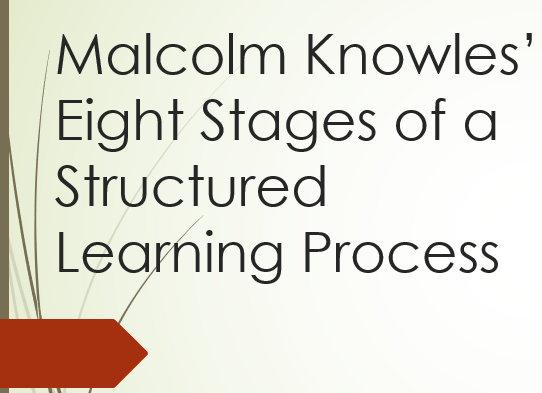Malcolm Knowles is well-known within education for his research on adult learning and adult education. He submitted that adults learn differently from children and therefore needed to have a learning plan with different foundations and premises which led to his concept of premises of adult learning.
He also coined the term ‘andragogy’ simply meaning adult education. Andragogy is the art and science of adult learning (Kearsley, 2010).
Knowles also recorded eight processes that lead to optimal learning. These processes can also be referred to as stages.
Identify Needs
The learner will carefully identify the information gap between what is known and what needs to be known. This will be their best attempt as the learner will obviously begin to recognize the different things that never thought of. For example, when attempting a new home improvement project, an individual may watch videos, read and talk to experts before starting. Then, as they begin, they may realize they needed more information.
It can be valuable to record these needs and keep track of them.
Learning Objectives
Take the time to identify what is the purpose. What are you hoping to learn? What do you want to show as proof of your learning? This could be a series of statements that will guide the learning experience.
Resources and Strategies
Simple, right? With our digital age, there are innumerable pieces of information available. It is important to recognize and know the difference between valid and reliable sources. Let’s look at an example. When looking up best treatment options for cancer, would you prefer to get your information from the Mayo Clinic or from Aunt Sally’s BlogSpot? Although Aunt Sally may have some good information or maybe even have survived cancer, it is important to start with a source with proven results.
Strategies is a dive into the best ways to learn the information. Back to our cancer example. You probably don’t want to learn through trial and error. It would be better to get a good opinion from an expert. However, trial and error would be a good choice or option with inventing something.

Assessment
Assessment is nothing more than the proof that learning was accomplished, and goals were met. Ask yourself:
- How do I know I met my objectives?
- How do I know I have learned the material?
- How can I prove I know the information?
- How do I plan this assessment and demonstrate it?
Validation
Validation is the proof of accuracy. This is the criteria or measurement of learning. In a formal classroom, this could be the rubric. In an informal learning environment, a self-assessment could be involved.
Review
Review this information. Share it with someone else. Have them proof the information and see what improvements they would make.
Act
Simple – go get it done!
Evaluate
Now that the learning is accomplished or the action plan is done, it is important to evaluate how the action plan. This is the time to evaluate whether or not the objectives have been met and make further plans to determine if any additional learning needs to be accomplished.
Although these are the steps created by Malcolm Knowles, I am firm believer and subscriber to the reflective practice. Be sure to go back through the learning process and reflect on what was learned or accomplished. What would you do differently? What were the wins? What were the ways in which improvement could be made?
Sources:
Eight Stage Learning: A Guided Learning Journal from Conception to Reflection.
Kearsley, G. (2010). Andragogy (M.Knowles). The theory Into practice database. Retrieved from http://tip.psychology.org
Knowles, M. (1975). Self-Directed Learning. Chicago: Follet.



Comments are closed